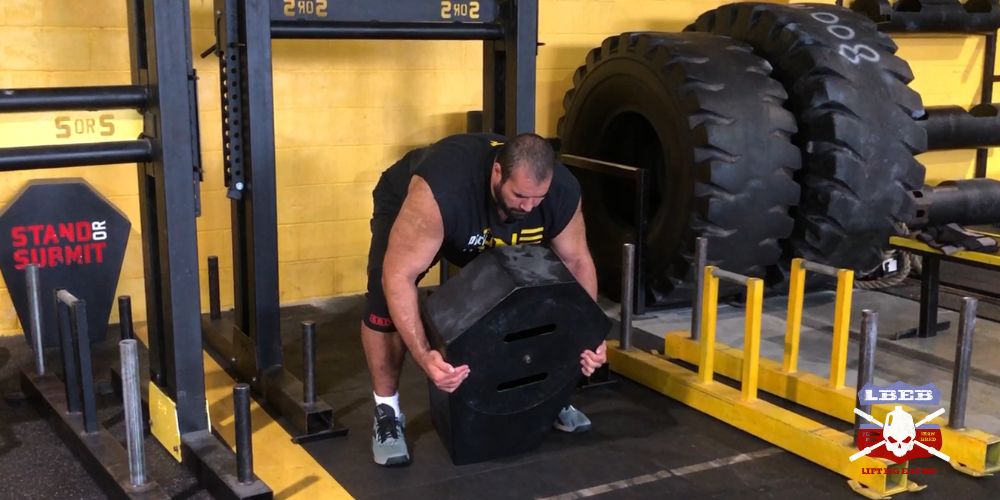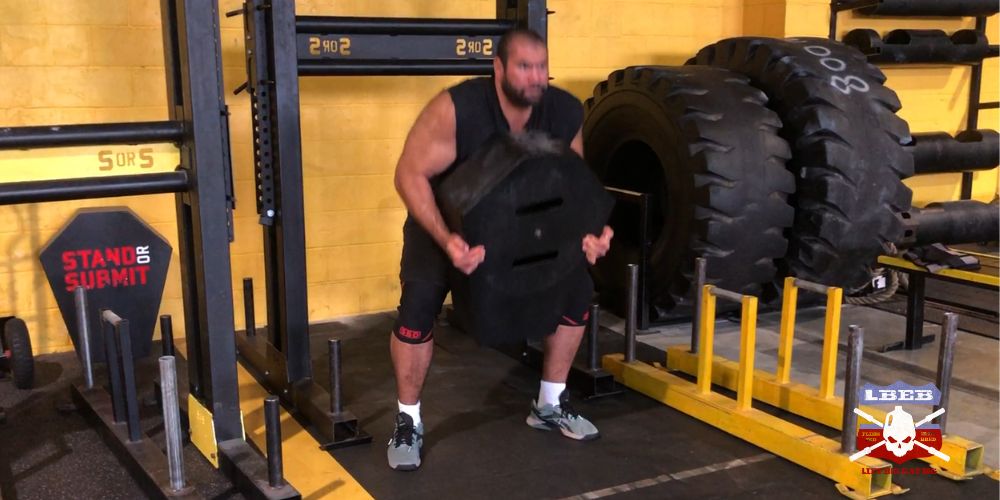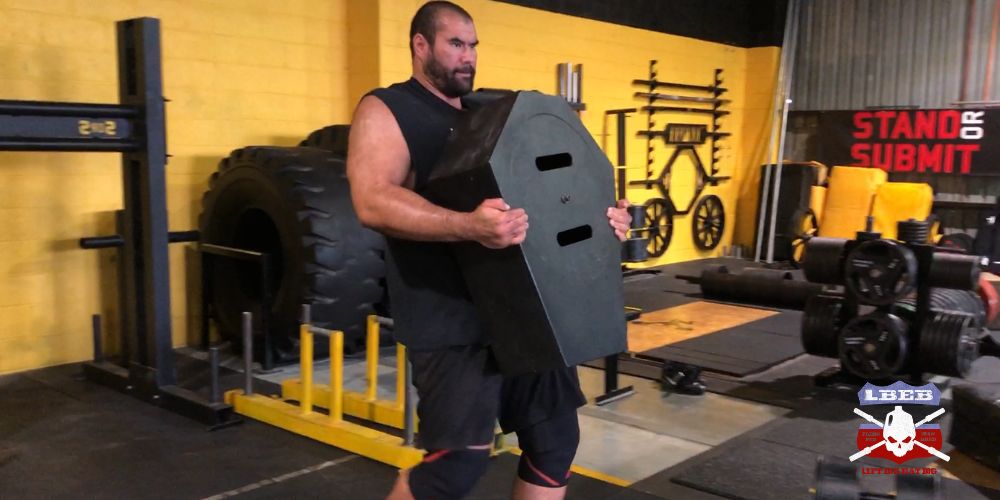Before nicely balanced, machined plates and barbells, humans had to prove their strength by lifting various shapes and sizes of rocks.
Perhaps the most well-known and infamous stone is the legendary Husafell stone in Iceland. Weighing in at 186kg / 410lbs, this monstrous stone was originally used to keep the gate shut on a goat and sheep pen.
The stone was used as a test of strength; lifting it to your knees granted you the title “lazy bones”; if you could lift it above your waist, you were called half-strong. However, to gain Fullsterkur status (full strong), one must lift the stone to chest height and carry the stone around the 34-meter sheep & goat pen.
For those of you reading who are not familiar with Strongman, let me tell you this is a world-class feat of strength. Carrying an unbalanced awkward-shaped 400 lb stone is not something easily done by modern strongmen whose lives revolve around being big and strong.
So for people without access to modern gyms and nutrition to be attempting this in the 1800s is awe-inspiring and a reminder that you don’t need access to fancy machines and equipment to be strong.
The World’s Strongest Man competition also used the legendary stone in 1992, where its popularity spawned its own event.
While there is only one original Husafell Stone, the “Husafell” carry event is often seen in modern-day competition using metal replicas of the original.
While IMO not as “cool” as the original, metal Husafell or shield carry implements are much more practical as they are loadable, and each side has the same dimensions. Thus you can use progressive overload to lift more safely over time instead of going straight to 400 pounds.
Table of Contents
Husafell Carry Technique For Strongman
In general, all kinds of front carries are similar. I will mainly discuss how to carry the metal version of the Husafell, also known as a shield carry.
The same technique can apply to a natural stone. However, each stone has its own individual shape and size. Therefore, it’s best to learn each stone’s intricacies from someone familiar with it.
Step 1: Getting Into Position

To pick up the Husafel implement, I like to step my feet to either side of the implement and tip it forward. From here, you want to squat down nice and deep, wrapping your arms around the implement just below the widest points on the sides.
If the implement is not very thick for you, you can wrap your arms around it and clasp your hands together. This is a powerful position, and the best Husafell carries are often tall, which allows them to do this.
If this is not you, you will still need to wrap your hands as far as possible. This might be barely getting around the implement, to having it sit predominantly in the crooks of your elbow and forearm. Either option is ok.
There is another option involving a staggered grip. Personally, I think it’s better to master the regular way for a beginner, though.
Step 2: The Pickup

To pick up the Husafell, think of it like a Zercher squat, where you drive your hips forward on the way up.
The higher you can get the implement on your chest, the better; as you walk, your upper back and arms will start to fatigue, causing the implement to drop.
So the higher you can start, the longer you can keep it high, which keeps the implement out of the way of your legs, allowing you to move quickly.
Once you’ve got it up nice and high, you want to push your hips slightly forwards and lean back slightly. This will allow the weight to be spread across your torso.
If you stand perfectly erect, the load will go directly to your biceps, a recipe for disaster for such a heavy load. This event can be very hard on the bicep tendons, so ensure you warm up correctly.
Step 3: The Carry

The carry is a relatively simple technique; you want to take short, fast steps to remain stable and take half breaths. If you get the implement nice and high on the chest, you can take longer strides until it starts to sink.
Breathing is vital in this event as the weight crushes the air out of your lungs; however, taking a full breath will cause you to lose your brace and drop the implement, so practice taking half breaths from a braced position.
Husafell Stone Carry Benefits
Mental Toughness
This implementation can be absolutely soul-crushing and humbling. However, once you learn to embrace the pain and find comfort in the uncomfortable other events and exercises no longer seem as daunting.
Unique Combination Of Strength And Conditioning
Just like other variations of front carries, the Husafell combines the need for high force output (strength) with a cardio component, as your heart rate will skyrocket from doing these, especially for max distance.
This can make the exercise very time efficient if you are looking for an option to hit different attributes quickly.
Real-World Strength
The Husafell is such an awkward carry, but it also transfers to carrying about anything else, like wrestling-type training or helping your buddy move furniture.
The core and upper back must be super strong, your ability to brace and breathe simultaneously will be tested, and you will try to stay upright when an awkward implement is pulling you forward.
When I did MMA, our coach made us carry each other around the gym from a body lock. You will find this drill a breeze once you get proficient at carrying Husafells.
Husafell Carry Muscles Worked
Almost the whole body is worked in this movement. The hamstrings, quads, glutes, and calves work hard to propel you forward.
The core and lower back are working hard to maintain your posture, and your upper back and arms are fighting as hard as possible to prevent the implement from falling downwards.
How Heavy Is The Husafell Stone?
The Husafell stone is 186kg / 410 lbs.
Husafell Carry World Record
Hafthor Bjornsson holds the world record for carrying the stone 98 meters in Icelands Strongest Man 2019. Below is a video of him carrying the stone in its original habitat. Remember, in the video, he is 6 feet 9 inches tall and weighs around 190kg; the stone is huge.
Husafell Stone Carry Alternatives
Plate Carries
If you don’t have access to a Husafell or Shield but have a loading pin, then plate carries are a good option. They can be hard to load super heavy unless you have thin metal plates.
They require open-hand grip strength, provided you don’t grip holes in the plates. They still require upper back core and leg strength to do effectively and also get the heart rate going.
Keg Carries
Carrying a keg can be a suitable alternative if you have them available. The core mechanics remain the same, but the most common way to lift the keg off the floor is to stagger the hands with one on each side of the keg. You can then regrip with the keg on their knees.
Sandbag Carries
Sandbags carried vertically can be a fantastic substitute for the Husafell carry. Larger ones can even simulate the implement getting in the way of the legs.
However, because of the smaller shape of the sandbags, athletes can often link their hands around the bag, giving a very strong carry position. This can be positive or negative, depending on your weakness.
Husafell Stone Carry Workout
A great way to implement Husafell carries is to add them at the end of a deadlift or leg day for 2 long sets—something like 2 x 30-50m. If you are training them specifically for a competition, you should simulate the competition or as close as possible, provided it’s not too heavy.
In competition, it’s often done for maximum distance, so getting used to longer carries from the start is a great option, as it’s often those final 10 meters where your vision starts to blur and your legs feel like jelly that makes the difference.
Summary
The Husafell (or replica) Stone carry, while soul-crushing and absolutely brutal, can be so rewarding and empowering. Knowing that humans have used these kinds of events as a test of strength for centuries can give you that extra bit of motivation to push through and master the uncomfortable.
So if you’ve got access to one of these implements, don’t sleep on it, it can help improve your performance both physically and mentally.
